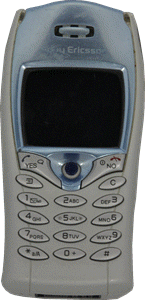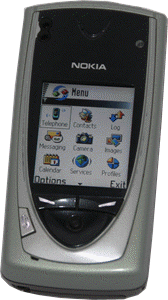The first camera phones

In July 2002, Andrew Harrison, the CEO of Carphone Warehouse, took his vacation in Italy. On the first day of his holiday he sent a picture of Tredozio near Bologna back to his office in the UK, using a camera phone and MMS. He wanted to show his colleagues back in the UK the future of the picture postcard. Harrison hoped that camera phones would save the industry and the Carphone Warehouse from oblivion.
When Sharp launched the world's first camera phone, the Sharp J-SH04, in November 2000, Japanese teenagers bought them in their millions. The outlook for similar success in Europe, though, looked doubtful. A certain level of take up, pundits thought around 30%, was needed before people would want to buy camera phones in large numbers. If your friends did not have one, there was little point in you having one.
The European roll out was slow and cautious. Ericsson did a deal with Vodafone to supply the infrastructure and the first phone that supported MMS, but first steps as far as customers were concerned were tentative.
Vodafone D2 launched an MMS service in Germany and there was Westal in Hungary, Oni in Portugal, Telnor in Norway and Telecom Italia in Italy all doing the same in the first half of 2002.[1]

The first UK service came in June 2002. T-Mobile's picture messaging service offered only one phone, the Sony Ericsson T68i, with a camera attachment. Customers had to pay an extra £20 per month to use the service as well as £200 for the phone. Commentators thought that these high costs would exclude young consumers, who were the most likely to use the service.
Orange, Vodafone and O2 followed with their own services by August 2002. By then Nokia got their long awaited 7650 phone onto the market. It was just what the market needed, a phone with a built in camera. The Nokia 7650 was much more than that though. Its Symbian OS offered picture management, a calendar and a to-do list. It was a pre-3G smart phone and you could get one from Carphone Warehouse for less then £200 with a Vodafone contract. [2]
It was still not obvious that phones with cameras were good thing. However, the Nokia 7650 became one of the most desirable gadgets for a short time and made all consumer phones without a camera old hat. The cost of picture messaging came down and the industry had given their customers a reason to upgrade and operators prepared for the next revolution, 3G.
References
1. Telecom Italia Mobile launches MMS, published by the Sunday Business Group EuropeMedia in 22 May 2003
2. Can Nokia save us? by Paul Durman, published in the Sunday Times 4 August 2002
Article by Steven Braggs, November 2011, corrections June 2012 and May 2013
Comments